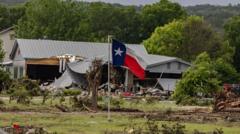The National Oceanic and Atmospheric Administration (NOAA), responsible for crucial weather and climate updates, is preparing for significant workforce reductions as part of a series of cost-cutting measures mandated by the Trump administration. Reports indicate that NOAA may lose an additional 1,000 employees, which follows approximately 1,300 staff resignations and layoffs recently. As the agency heads into the hurricane season, concerns are mounting that these cuts will severely impact its ability to deliver lifesaving forecasts and vital services.
NOAA Faces Significant Staff Cuts Amidst Concerns for Future Forecasts

NOAA Faces Significant Staff Cuts Amidst Concerns for Future Forecasts
The Trump administration's directive to cut NOAA's workforce raises alarms about the agency's capacity to provide accurate weather predictions as disaster seasons loom.
NOAA's workforce has already seen a decline of nearly 20 percent from its original size of around 13,000. The organization's managers have been instructed to formulate plans for layoffs and reorganizations, all aimed at meeting the new reduction quotas by Tuesday. This initiative is part of President Trump's push to streamline federal agencies alongside the efforts to restructure the federal bureaucracy, which has been vigorously backed by billionaire entrepreneur Elon Musk.
Inside sources have revealed that the proposals for reductions may lead to eliminations of key functions within NOAA, yet many managers have expressed confusion over which programs are deemed essential and should be preserved. Already, effects of prior staffing losses are observable, hindering capabilities across various NOAA operations, including the forecasting of hurricanes and tornadoes, regulatory actions over fisheries, and monitoring of climate change impacts. As staff near their limits, the integrity and accuracy of future safety predictions hang in the balance as this agency navigates unprecedented challenges.
Inside sources have revealed that the proposals for reductions may lead to eliminations of key functions within NOAA, yet many managers have expressed confusion over which programs are deemed essential and should be preserved. Already, effects of prior staffing losses are observable, hindering capabilities across various NOAA operations, including the forecasting of hurricanes and tornadoes, regulatory actions over fisheries, and monitoring of climate change impacts. As staff near their limits, the integrity and accuracy of future safety predictions hang in the balance as this agency navigates unprecedented challenges.





















